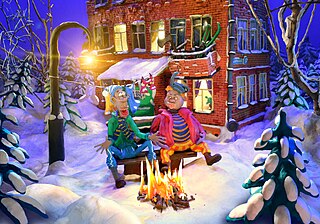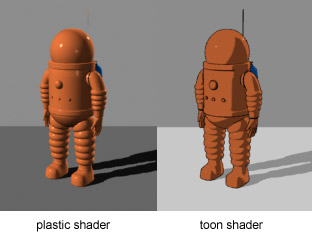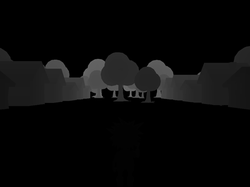
Animation is a filmmaking technique by which still images are manipulated to create moving images. In traditional animation, images are drawn or painted by hand on transparent celluloid sheets (cels) to be photographed and exhibited on film. Animation has been recognized as an artistic medium, specifically within the entertainment industry. Many animations are computer animations made with computer-generated imagery (CGI). Stop motion animation, in particular claymation, has continued to exist alongside these other forms.

Lilo & Stitch is a 2002 American animated science-fiction comedy-drama film produced by Walt Disney Feature Animation and released by Walt Disney Pictures. It was written and directed by Chris Sanders and Dean DeBlois and produced by Clark Spencer, based on an original story created by Sanders. It features Daveigh Chase and Sanders as the voices of the title characters and also features the voices of Tia Carrere, David Ogden Stiers, Kevin McDonald, Ving Rhames, Jason Scott Lee, and Kevin Michael Richardson. It was the second of three Disney animated feature films produced primarily at the Florida animation studio in Disney's Hollywood Studios at Walt Disney World near Orlando, Florida.
While the history of animation began much earlier, this article is concerned with the development of the medium after the emergence of celluloid film in 1888, as produced for theatrical screenings, television and (non-interactive) home video.

Claymation, sometimes called clay animation or plasticine animation, is one of many forms of stop-motion animation. Each animated piece, either character or background, is "deformable"—made of a malleable substance, usually plasticine clay.

Traditional animation is an animation technique in which each frame is drawn by hand. The technique was the dominant form of animation, until the end of the 20th century, when there was a shift to computer animation in the industry, specifically 3D computer animation.
Madhouse, Inc. is a Japanese animation studio founded in 1972 by ex–Mushi Pro staff, including Masao Maruyama, Osamu Dezaki, and Yoshiaki Kawajiri.
The history of Canadian animation involves a considerable element of the realities of a country neighbouring the United States and both competitiveness and co-operation across the border.

Drawn Together is an American adult animated sitcom created by Dave Jeser and Matt Silverstein for Comedy Central. It premiered on October 27, 2004, and ended on November 14, 2007, after three seasons and 36 episodes. The series is a parody of house-based reality shows such as The Real World, The Surreal Life, and Big Brother, and follows the misadventures of the housemates in the fictional show of the same name and uses a sitcom format with a reality TV show setting.
A cel, short for celluloid, is a transparent sheet on which objects are drawn or painted for traditional, hand-drawn animation. Actual celluloid was used during the first half of the 20th century, but since it was flammable and dimensionally unstable it was largely replaced by cellulose acetate. With the advent of computer-assisted animation production, the use of cels has been all but abandoned in major productions. Disney studios stopped using cels in 1990 when Computer Animation Production System (CAPS) replaced this element in their animation process, and in the next decade and a half, the other major animation studios phased cels out as well.
The Computer Animation Production System (CAPS) was a proprietary collection of software, scanning camera systems, servers, networked computer workstations, and custom desks developed by The Walt Disney Company and Pixar in the late 1980s. Although outmoded by the mid-2000s, it succeeded in reducing labor costs for ink and paint and post-production processes of traditionally animated feature films produced by Walt Disney Animation Studios (WDAS). It also provided an entirely new palette of digital tools to the animation filmmakers.

Adobe Flash animation is an animation that is created with the Adobe Animate platform or similar animation software and often distributed in the SWF file format. The term Adobe Flash animation refers to both the file format and the medium in which the animation is produced. Adobe Flash animation has enjoyed mainstream popularity since the mid-2000s, with many Adobe Flash-animated television series, television commercials, and award-winning online shorts being produced since then.

A production logo, vanity card, vanity plate, or vanity logo is a logo used by movie studios and television production companies to brand what they produce and to determine the production company and the distributor of a television show or film. Production logos are usually seen at the beginning of a theatrical movie or video game, and/or at the end of a television program or TV movie. Many production logos have become famous over the years, such as the 20th Century Studios's monument and searchlights and MGM's Leo the Lion. Unlike logos for other media, production logos can take advantage of motion and synchronized sound, and almost always do.
Wang Film Productions Co., Ltd. is one of the oldest and most prolific Taiwanese-American animation studios since 1978. The company, based in Xindian, Taipei and Los Angeles, California, has done traditional hand-drawn 2D animation/ink and paint for various TV shows and films for studios across North America, Europe and Asia-Pacific.
The New Fantastic Four is an animated series produced by DePatie–Freleng Enterprises and Marvel Comics Animation in 1978. It is the second animated series based on Marvel's comic book series Fantastic Four, following a 1967 series produced by Hanna-Barbera Productions.
Anime-influenced animation or Animesque is a type of non-Japanese works of animation that are similar to or inspired by anime. Generally, the term anime refers to a style of animation originating from Japan. As Japanese anime became increasingly popular, Western animation studios began implementing some visual stylizations typical in anime—such as exaggerated facial expressions and "super deformed" versions of characters.
Asaph Fipke is a Canadian producer, writer, and director and the creator of the animated series Storm Hawks, which is made by the animation studio he co-founded, Nerd Corps Entertainment, cooperation with Cartoon Network and YTV. He is also the creator of both the animated series Slugterra and Rated A for Awesome which aired on Disney XD and Endangered Species, which was also produced by Nerd Corps Entertainment that aired on Teletoon as well as the executive producer in the sixth and seventh seasons of My Little Pony: Friendship Is Magic, which currently airs on Discovery Family and game show Airmageddon, which airs on CBBC.

Nerd Corps Entertainment was a Canadian animation studio located in Vancouver, British Columbia. Founded by former Mainframe Entertainment producers Asaph Fipke and Chuck Johnson in 2002, it specialized in CGI animation, computer animation, and Flash animation.
ThunderCats is a media franchise, featuring a fictional group of cat-like humanoid aliens. The characters were created by Tobin "Ted" Wolf and featured in an animated television series named ThunderCats, running from 1985 to 1989, which was animated by Japanese studio Pacific Animation Corporation, and co-produced by Rankin/Bass Productions.
















